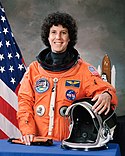Ellen S. Bakerová
| Ellen S. Bakerová | |
|---|---|
 | |
| Astronaut NASA | |
| Datum narození | 27. dubna 1953 (71 let) |
| Místo narození | Fayetteville, Severní Karolína |
| Čas ve vesmíru | 28 dní 14 hodin 31 minut |
| Mise | STS-34, STS-50, STS-71 |
| Znaky misí | |
| Některá data mohou pocházet z datové položky. | |
Ellen Louise Shulman Bakerová (* 27. dubna 1953, Fayetteville, Severní Karolína, USA) je americká lékařka a bývalá astronautka NASA. Z NASA odešla v listopadu 2011. Byla a v současné době (2017) je ředitelkou Astronaut Office Education/Medical Branch.
Narodila sa ve Fayetteville v židovské rodině, ale vyrostla v New Yorku. Vystudovala na třech univerzitách: na University at Buffalo získala bakalářský titul v oboru geologie, na Cornell University získala doktorát z medicíny a na University of Texas získala magisterský titul z veřejného lékařství (public health). Má za sebou tři vesmírné mise, a to STS-34 z října 1989, STS-50 z června/července 1992 a STS-71 z června/července 1995. Za svou kariéru kosmonautky strávila ve vesmíru 28 dní, 14 hodin a 31 minut.
Odkazy
Reference
V tomto článku byl použit překlad textu z článku Ellen S. Baker na anglické Wikipedii.
Externí odkazy
 Obrázky, zvuky či videa k tématu Ellen S. Bakerová na Wikimedia Commons
Obrázky, zvuky či videa k tématu Ellen S. Bakerová na Wikimedia Commons - (anglicky) NASA – Ellen S. Bakerová: Biografie
- (anglicky) Spacefacts – Ellen S. Bakerová: Biografie
Média použitá na této stránce
STS-34 Mission Insignia
STS-71 Mission Insignia
The STS-71 crew patch design depicts the orbiter Atlantis in the process of the first international docking mission of the Space Shuttle Atlantis with the Russian Space Station Mir. The names of the 10 astronauts and cosmonauts who flew aboard the orbiter are shown along the outer border of the patch. The rising sun symbolizes the dawn of a new era of cooperation between the two countries. The vehicles Atlantis and Mir are shown in separate circles converging at the center of the emblem symbolizing the merger of the space programs of the two space faring nations. The flags of the United States and Russia emphasize the equal partnership of the mission. The joint program symbol at the lower center of the patch acknowledges the extensive contributions made by the Mission Control Centers (MCC) of both countries. The crew insignia was designed by aviation and space artist, Bob McCall, who also designed the crew patch for the Apollo Soyuz Test Project (ASTP) in 1975, the first international space docking mission.
The crew patch of STS-50, United States Microgravity Laboratory-One (USML-1), captures a Space Shuttle traveling above Earth while trailing the USML banner. The Orbiter is oriented vertically in a typical attitude for microgravity science and in this position represents the numeral 1 in the mission's abbreviated title. This will be the first in a series of USML flights where the primary objective is microgravity science, planned and executed through the combined efforts of our country's government, industry, and academia.
Visible in the orbiter's payload bay are the Spacelab module, and the extended duration Orbiter "cryo" pallet which is being flown for the first time on STS-50. The small g and Greek letter mu on the Spacelab module symbolize the microgravity environment being used for research in the areas of materials science and fluid physics. The large block letter U extends outside of the patch's perimeter, symbolizing the potential for the experiments on this flight to expand the current boundaries of knowledge in microgravity science.
The Stars and Stripes of the USML block letter and the U.S. landmass visible in the Earth scene below the Orbiter reflect the crew's pride in the United States origin of all on-board experiments.



